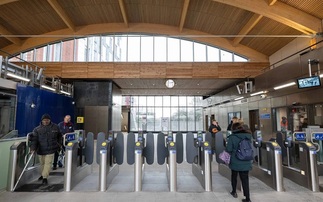A host of leading industry figures five their views on how can firms support and accelerate the transition to net zero buildings
From whichever angle you look, net zero buildings offer a compelling vision. They are the homes and offices of the future that promise to keep occupants cool in the summer, warm in the winter, and healthy in mind and body all year round, while also providing a critical component of the zero emission energy system that should emerge over the next decade.
And it needn't be a distant vision of the future, either. The green technologies required to deliver net zero emission buildings have already been developed and are slowly becoming more established in new and old buildings alike, while construction firms are thinking increasingly carefully about the environmental impacts of the materials and equipment they use. There are signs, too, that the financing and investment tools needed to drive these urgently-needed changes are starting to gain traction.
Not that any part of this transition is easy, of course. Buildings contribute around 30 per cent of the UK's total carbon emissions, and 80 per cent of the buildings expected to be standing in 2050 have already been constructed. It will be a mammoth task to unlock the investment, build the markets, and ramp up the demand for green home retrofits that are required to meet the UK's net zero goal over the coming decade and beyond.
So why and how can businesses support and accelerate the transition to net zero buildings, while also maximising the financial and productivity opportunities? To explore these issues and more, a host of industry experts and leading business figures last month came together for BusinessGreen's exclusive half day conference - Towards Net Zero Buildings - hosted in partnership with property giant Landsec.
Investment, of course, is crucial, and the government's own estimates suggest as much as £65bn will be needed just to get existing housing stock up to energy performance certificate (EPC) rating C by 2035, with even more needed thereafter to reach net zero by 2050 and fully decarbonise heating systems.
That is why the Green Finance Institute - established by the government and City of London Corporation to foster collaboration between public and private sector in unlocking green investment - last year launched the Coalition for the Energy Efficiency of Buildings (CEEB), which aims to explore how to accelerate the development of the market for financing net zero and climate-resilient buildings.
As Emma Harvey, programme director at the GFI, explained, there remain huge barriers to retrofitting properties that need overcoming in order to drive up investment across the sector. These include long payback periods on energy efficiency measures, split incentives between landlords and tenants in terms of who pays for the retrofit and who benefits, and also many behavioural factors, such as a lack of trust in the supply chain or such work being seen as a hassle by homeowners.
To tackle these issues, CEEB is currently testing a raft of green finance mechanisms which aim to act as catalysts to drive wider take up across financial markets, such as green mortgages, green home salary sacrifice schemes, green rental agreements, and building renovation passports.
After many years of frustrating progress on the low carbon buildings agenda, Harvey believes both the market and demand for green retrofitting and associated financial tools are finally picking up.
"It is a bit of a 'chicken and egg' scenario, because financial institutions typically like to innovate products into a space where they see demand, but equally having the finance available can help homeowners to feel more comfortable in going for renovations," she explained. "But what I would say is there is really strong demand from financial institutions at the moment to be bringing to market these green products."
Harvey, incidentally, played a key role in the launch of the UK's first green mortgage while she worked at Barclays, which she argued has been hugely influential in piquing broader market interest in such financial products. And, following the launch of the government's Green Homes Grant Scheme, even more green building financial products are being launched to support the scheme, according to Harvey, who highlighted the importance of effective policy frameworks in helping drive market demand.
But the market also needs stimulating for the public sector, too, with schools, hospitals, prisons, and leisure centres all requiring investments in green upgrades over the coming decade and beyond. One government-led project currently underway is looking specifically at how to create sustainable new designs for secondary school buildings, with the help of Innovate UK, the Construction Innovation Hub, and the Active Building Centre. Dubbed GenZero, the research and development initiative aims to set the standard for the next generation of zero carbon schools in England, by delivering two prototype sustainable schools built using off-site construction methods - one for a suburban site and the other for an urban site.
Leading the project for the Department for Education is Tom Stocks, who explained that the aim is to provide an exemplar for operational low carbon schools, with resulting designs also intended to provide guidance for plenty of other public buildings. "What we're finding with this is that standardisation and consistency has got to be at its core, and also increased use of timber," he said. That also applies to the wider site, with designs being drawn up for tree shade to provide cooling in the summer and let light in during wintertime, for example.
"GenZero isn't just about the buildings, it's about the entire site," Stocks added. "We're looking at a standardised solution for different types or sizes of landscape that are available for different school buildings."
While baking in greener thinking right at the outset of the design and landscaping stage is crucial for delivering net zero buildings, the next stage is ensuring the construction process is as cost and carbon efficient as possible.
Also speaking at the event, Jamie Johnston, director and head of global systems at technology-led design company Bryden Wood, provided an overview of some of the repeatable, manufacturing approaches being dialled up in support of green construction projects. Known as 'platforms', the approach enables new buildings to be designed and constructed using a pre-defined 'kit of parts', which Johnston argues demonstrate greater whole-life value, lower carbon and energy use, and better safety. Again, echoing Stocks' findings, Johnston said greater standardisation could cut costs and boost carbon efficiencies.
"The long-term vision is that in 10 years' time we're doing an awful lot more platforms," he explains. "The reason that's important is, if you look at the metrics, if you assume they get better over time, and then you multiply them by the scale of the government pipeline, you start to see how we can make some massive, massive savings in terms of cost - but importantly also in terms of carbon, better productivity, better manufacturing jobs, upskilling people and solving the skills gap. The benefits to wider society are absolutely vast."
So, if the investment tools are scaling up, the greener, more holistic designs are being sought, and there is growing demand for more efficient and sustainable construction processes, how can the sector overcome the barriers that have slowed progress to date and demonstrate that there is a compelling business case for net zero buildings and retrofits?
Government policy, clearly, needs to do a lot more of the heavy lifting, as was highlighted by a host of leading figures from innovation agencies, engineering consultancies, property developers, and green business groups in a discussion to round out the morning's event.
The Prime Minister's Ten Point Plan for a 'Green Industrial Revolution' contained a number of welcome signals that ambitious policy levers and targets to drive decarbonisation of the built environment are perhaps finally being given urgently-needed due attention across Whitehall. As well as the Green Homes Grant scheme and funding to support public building upgrades, the Plan set out goals to deploy 600,000 heat pumps a year by 2028, deliver the UK's first town heated by hydrogen by 2030, and hinted at a potential earlier implementation date of the Future Homes Standard to rid all new-build homes of fossil fuel heating from the mid-2020s.
"We're finally seeing some momentum, and [the Ten Point Plan] is a great move forward and a very welcome move," said Landsec sustainable design executive Alexia Laird. "It gives a strong market signal, but there is a lot of detail still required."
More policy documents are also due next year - such as a Construction Playbook and Heat and Buildings Strategy - that could shine further light on the UK's net zero buildings vision and help unlock much-needed investment and market demand. But for Ashley Bateson, a partner at engineering and design consultancy Hoare Lea, it is not just about specific policy details, but the nature of how those policies are designed in the first place, that holds the key to unlocking a step change in progress.
"Building regulations at the moment are all about construction standards and not outcomes," he explained. "What would be transformational is if we said that it's the performance of buildings measured in their use that would be rewarded. But whether that's a shift that comes in the next policy, though, we'll wait to see."
A major barrier to businesses investing in more sustainable buildings or upgrades is the lack of incentives - or at least, the perception of a lack of incentives - according to Bateson. Many property owners and developers still do not believe they can easily secure higher rental values or sell their property at a profit if they invest in more sustainable buildings, despite growing evidence to the contrary. Meanwhile, the tax system often fails to provide a clear financial incentive for improving existing buildings. "At the moment, there are there aren't enough incentives to perhaps reward developers that do good practice," he explained. "However, there is a lot of pioneering work from developers such as Landsec that have really got the big picture. And there's a number of other developers that are also at the forefront of understanding that the net zero agenda is part of the brand, and that value is about managing risk, protecting shareholder value, and taking a pro-active approach to embrace the future."
Increasingly, Bateson argued, developers are starting to understand that attention to social purpose and long-term legacy can make for a more attractive building for tenants, which may delivers higher rental value. Indeed, studies have shown that more sustainable buildings are attract higher rents and are less likely to be empty.
But is that message getting through to businesses? Ana Musat, policy manager at the Aldersgate Group, certainly thought so. "Just looking at the businesses that we work with, a lot of them see this not as a cost but as an investment," she said, highlighting early movers in the low carbon building space such as concrete manufacturer Cemex, which has a target to reach net zero across its operations and products by 2050. "That's a pretty big cost for a business that has pretty thin profit margins, but actually the company sees it as an investment because low carbon cement and concrete is going to play a key role in the low carbon infrastructure we need to get to net zero. So in the run up to 2050 they are going to be very well placed to capture that first-mover advantage."
The challenge, according to Musat, is supporting small and medium businesses with lower budgets to make those green investments to futureproof their buildings. Here, as ever, national and local policy has a key role to play, but so does technology, if innovators can get these smaller companies on board. Heat pumps and energy management systems are, after all, quite disruptive technologies.
To persuade more businesses to take the plunge, Innovate UK is therefore helping to fund projects that can demonstrate how, when deployed at scale, green building and construction technologies and approaches can boost benefits while cutting costs. Mike Pitts, deputy challenge director for transforming construction at the innovation agency, highlights simple ideas such as building roofs on the ground before lifting them into place, saving time and effort for roofers who do not need to scale the top of the building to do their work. But other factors that need to change also relate to cultural attitudes, he argues. "No one ever complains about having fancy stone cladding on the front of a building, because they think it looks good," explained Pitts. "But I suspect that probably costs a whole lot more than cladding the whole thing in solar PV. So some of it is about cultural attitudes."
As the risk equations shift across all sectors of the economy as the pursuit of what are now very stretching climate targets in the UK over the coming decade gather pace, some of those cultural attitudes are certain to shift in a greener direction. The replacement of gas boilers with heat pumps and hydrogen alongside energy efficient retrofitting measures is sure to be one of the most challenging, urgent, and public-facing stories of the net zero transition in the 2020s, which is set to place green buildings right at the heart of the conversation. Alongside that, shareholders are increasingly pushing businesses to prepare to a greener future, and so looking beyond upfront capital costs to longer-term value in buildings is likely to become increasingly common.
So perhaps the best business case of all for net zero buildings is simply getting ahead of the curve, rather than being left behind in what is increasingly looking an inevitable trend.
"Start the transition early because that's the way the market is going," advised Musat. "The government is going that way and consumers are embracing the change, so the earlier you make that transition, the better place you're going to be in as we approach 2050."









